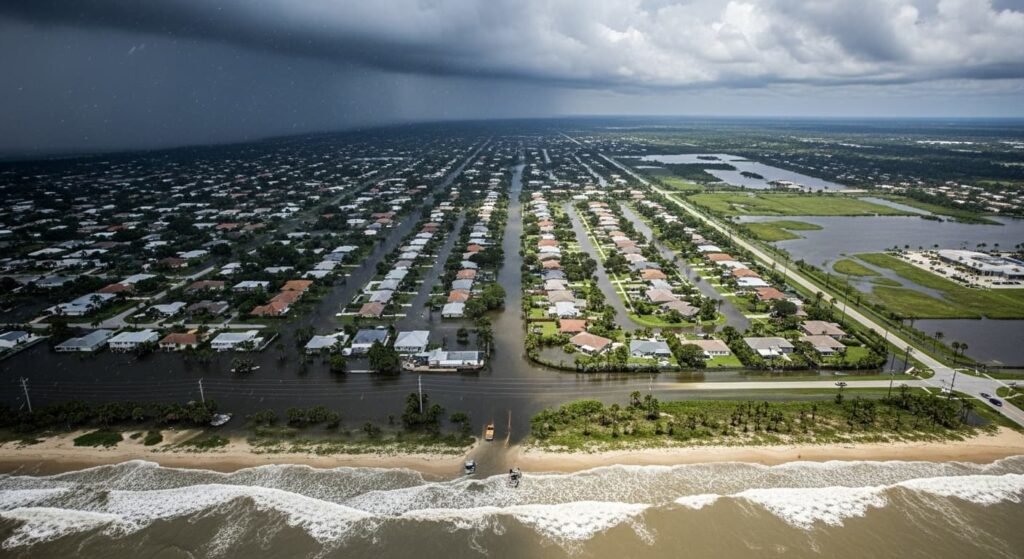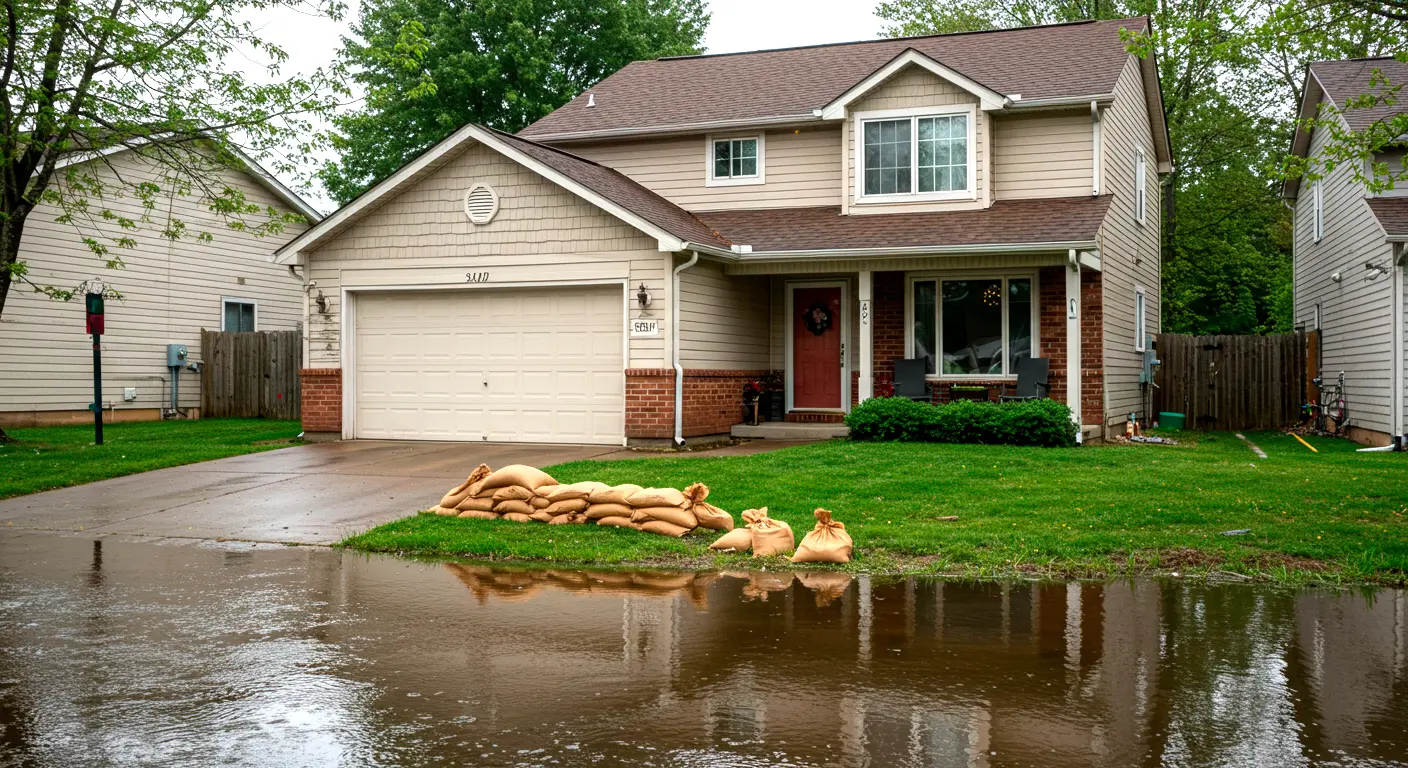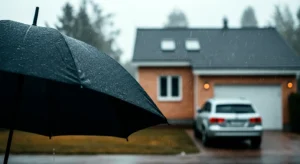The Central Florida Reality Check Every Homeowner Needs
Florida is a paradise. We live for the sun, the theme parks, the beautiful landscapes, and the relaxed lifestyle that comes with it. The allure of the Sunshine State is undeniable, drawing people from across the nation and the globe to settle in dynamic regions like Central Florida, the heart of our state’s inland excitement. But as any resident of Orlando, Kissimmee, Lake Nona, or any community in the surrounding counties knows, our paradise comes with a seasonal trade-off that demands serious attention: water.
We are all familiar with the intense, localized, “summertime storms”—the daily, torrential downpours that drop several inches of rain in a single hour. When these daily routines combine with the massive rainfall from a lingering tropical storm or hurricane, the result is often an overwhelming amount of water that our flat landscape, drainage systems, and retention ponds simply cannot handle. This reality forces every homeowner to ask a critical, financial question: Am I truly protected from flood damage?
The most common, and most dangerous, misconception in our region is that your standard homeowners insurance policy will protect you from the financial fallout of rising water. For most homeowners, the coverage they assume they have simply doesn’t exist in their standard policy. As a trusted insurance company in Florida built for your generation, Poncho Insurance is here to debunk this myth, dive deep into the specific risks facing Central Florida, and show you how to close the most critical and potentially devastating gap in your home’s financial protection.
The Great American Insurance Blind Spot: The Homeowner’s Policy Exclusion
Let’s be absolutely clear: Standard Homeowners Insurance (HO-3 or similar) does not cover damage caused by flooding. This is not a subtle clause; it is an explicit, industry-wide exclusion. If you review the “Exclusions” section of your current policy, you will find that damage resulting from “flood,” “rising water,” or “surface water” is specifically listed as a peril that is not covered.
To understand why this distinction is so crucial, you must understand how the insurance world separates water damage:
- Sudden & Accidental Water Damage (Covered by Home Insurance): This typically refers to water that originates inside your home or from a specific, internal event—such as a burst plumbing pipe, a sudden leak from a hot water heater, or an overflowing washing machine. This damage is usually covered because it is sudden and originates within the confines of the home’s systems.
- Flood Damage (Excluded by Home Insurance): This is defined as a general and temporary condition where water inundates two or more acres of normally dry land or two or more properties (one of which is yours). This damage is caused by external forces like the overflow of inland or tidal waters, the unusual accumulation of surface waters, or mudflow.
The distinction is clear: if the water comes from the ground up, entering your home’s foundation or lower levels due to external rising water, it is a flood. In the absence of a separate flood policy, every dollar of resulting damage—from foundation repair, structural beam replacement, and mold remediation to ruined furniture, appliances, and personal belongings—comes entirely out of your own pocket. This is the difference between an inconvenient repair and a financial catastrophe.

Florida’s Unique Flood Risk: It’s Not Just Coastal Anymore
Many people in inland Florida, especially those in the dynamic and rapidly growing areas around Orlando, Lake Mary, and Kissimmee, dismiss the need for flood insurance because they believe it’s only a coastal problem involving storm surge. This is a hazardous and outdated assumption, particularly for the Sunshine State, where water management is a constant challenge.
- Flat Topography and the Urban Sprawl
Central Florida is notoriously flat. While beautiful, this means that heavy rainfall doesn’t drain quickly. The water has nowhere to go but up and out, a problem compounded by the rapid pace of development. As fields and natural areas are paved over for new neighborhoods, shopping centers, and infrastructure, the ground loses its ability to absorb water. The result is increased surface water runoff, which quickly overwhelms municipal drainage systems and causes street flooding that backs up into yards and, inevitably, into homes.
- The Role of Lakes, Ponds, and Retention Systems
Our region is defined by its water features—the Chain of Lakes, and thousands of smaller lakes, ponds, and retention areas designed explicitly to manage stormwater runoff. When a major storm hits, these systems quickly reach capacity. Once a retention pond overflows its engineered limits, or a natural lake surpasses its banks, the resulting damage is classified as flooding. You don’t have to live right next to a major body of water; localized flooding can occur from a small retention pond a block away when the municipal drainage system fails during a heavy rain event.
- The “Low-Risk” Fallacy and the Flaws of FEMA Maps
The biggest mistake homeowners make is relying solely on FEMA’s Flood Insurance Rate Maps (FIRMs). These maps designate Special Flood Hazard Areas (SFHAs) where flood insurance is mandatory for federally-backed mortgages. If your lender doesn’t require it, you are in a low-to-moderate risk zone.
However, the truth is that flooding can happen anywhere, especially in a state dominated by water. The statistics are irrefutable: Close to one-third of all flood insurance claims paid by the National Flood Insurance Program (NFIP) are for properties outside of these high-risk areas. Furthermore, in your Central Florida home, you are statistically more likely to experience a flood over the next 30 years than a fire.
FEMA maps are historical tools, not predictive ones. They may not account for recent development, aging infrastructure, or the increasing intensity of modern rainfall events. Waiting for a high-risk designation to buy a policy is not a gamble worth taking; it’s an unnecessary exposure to risk that can be easily mitigated.
Understanding Your Options: NFIP vs. Private Flood Insurance
In Florida’s dynamic and often challenging insurance market, you have two primary avenues for obtaining flood protection. Understanding the differences between these options is key to getting the right coverage that fully protects your investment.
- The National Flood Insurance Program (NFIP)
The NFIP is the federal government program managed by FEMA. It offers a standardized policy across all participating insurance providers. While reliable, it has fixed and often limiting parameters:
- Coverage Limits: The NFIP has mandated maximum limits: up to $250,000 for structural coverage (the building) and up to $100,000 for contents (personal property). For many larger or recently renovated Central Florida homes, the rebuilding cost can easily exceed these limits, leaving the homeowner significantly underinsured.
- Limited Scope: The NFIP typically does not cover crucial indirect expenses, such as Additional Living Expenses (ALE). If a flood forces you out of your home for months during repairs, the cost of temporary housing, meals, and storage falls entirely upon you.
- The Private Flood Insurance Market
The Private Flood Insurance Market has experienced significant growth in Florida. Private policies are written and backed by private insurance carriers and reinsurers, often offering more flexible and robust protection:
- Higher Limits: Private policies frequently provide higher coverage limits that more accurately reflect the true replacement cost of high-value Florida homes. This is vital for protecting large investments in areas like Dr. Phillips or Lake Nona.
- Broader Coverage: Options for coverage often include benefits that NFIP excludes, such as coverage for basement contents, detached structures (sheds, detached garages), and, crucially, Additional Living Expenses (ALE) coverage.
- Competitive Pricing and Flexibility: For homeowners in low-to-moderate risk zones, private market policies can sometimes offer more competitive premiums than the NFIP. Furthermore, private carriers may utilize advanced modeling to quote a home without the costly and time-consuming requirement of an Elevation Certificate, simplifying the process for the consumer.
Choosing the right policy requires an analysis of your home’s value, your personal assets, and your risk tolerance. It’s not simply about checking a box; it’s about getting sufficient coverage.
The Financial Fallout of Going Without Flood Insurance
To fully appreciate the need for this coverage, consider the financial consequences of a flood event without a policy in place:
- No Federal Bailout: Contrary to popular belief, federal disaster assistance is not a handout. It is typically a small, low-interest loan that you must repay. It is rarely sufficient to cover the full cost of rebuilding a home.
- Total Loss of Equity: A flood is one of the few perils that can completely wipe out your home equity overnight. You will still be responsible for your mortgage payments on a house that may be uninhabitable or condemned.
- The Hidden Costs: Flood damage is insidious. Beyond the obvious damage to walls and flooring, you face mold and mildew remediation, which is expensive and often medically necessary. The loss of personal belongings—furniture, electronics, clothing, irreplaceable items—represents thousands of dollars lost forever.
The cost of flood insurance, especially in low-to-moderate risk areas, is a tiny fraction of the cost of a single major repair. It is the definition of a smart, protective investment.

Preparation and Claims: What You Need to Know
Getting flood insurance is the first step; knowing what to do afterward is the second. Since a 30-day waiting period typically applies to all flood policies (both NFIP and private), the time to buy is now, not when a storm is forming in the Atlantic.
Before a Storm:
- Document: Create a thorough inventory of your personal property (contents) and take photos or video of all areas of your home. Store this documentation digitally and off-site (in the cloud).
- Elevation: For properties in risk zones, understand your home’s base flood elevation (BFE) and take necessary precautions to elevate critical systems (furnace, water heater).
After a Flood (Filing a Claim):
- Safety First: Do not enter your home until authorities confirm it is safe. Beware of electrical hazards and contaminated water.
- Document Damage: Take extensive photos and video before you begin cleanup. This evidence is critical for your adjuster.
- Separate and Hold: Separate damaged property from undamaged property. Keep samples of damaged materials. Do not discard items unless absolutely necessary; if you must discard, photograph them and keep receipts.
Poncho Insurance: Your Partner in Simplified Flood Protection
We built Poncho Insurance to eliminate the complexity and jargon that makes policies like flood insurance intimidating. As your trusted Insurance Company in Florida, especially serving the Central Florida community, we make getting covered simple, transparent, and smart. We are digital-natives committed to providing straightforward protection for the things you care about.
Here’s how Poncho Insurance simplifies your flood insurance needs:
- Risk Assessment, Simplified: We use advanced data tools to pinpoint your exact risk exposure according to FEMA maps and other modeling. No confusion, just clear data. We don’t guess; we rely on solid information to guide your policy choice.
- Dual Market Shopping: Our digital platform and expert agents don’t just quote the NFIP. We actively shop both the NFIP and the robust Private Flood Market to ensure you get the broadest possible coverage at the most competitive rate for your specific location in Orlando, Winter Park, or Kissimmee. Our goal is to find you a policy with the highest limits and the best coverage benefits, such as ALE, for your money.
- Seamless Bundling: We integrate your flood policy with your Homeowners and Auto insurance, simplifying your billing and management while maximizing your savings (often significant when bundling multiple policies). We believe insurance management should be as easy as using your favorite digital apps.
A flood is an emotional and financial disaster. With Poncho Insurance, you get the robust, customized protection you need without the complicated process you don’t. We are here to ensure that when the inevitable rising water threatens your property, your coverage—and your peace of mind—are firmly in place.
Ready to stop gambling on the weather? Join thousands of others who have switched to simpler, smarter coverage. Get a straightforward flood insurance quote from Poncho Insurance in minutes and ensure you’re truly covered.




